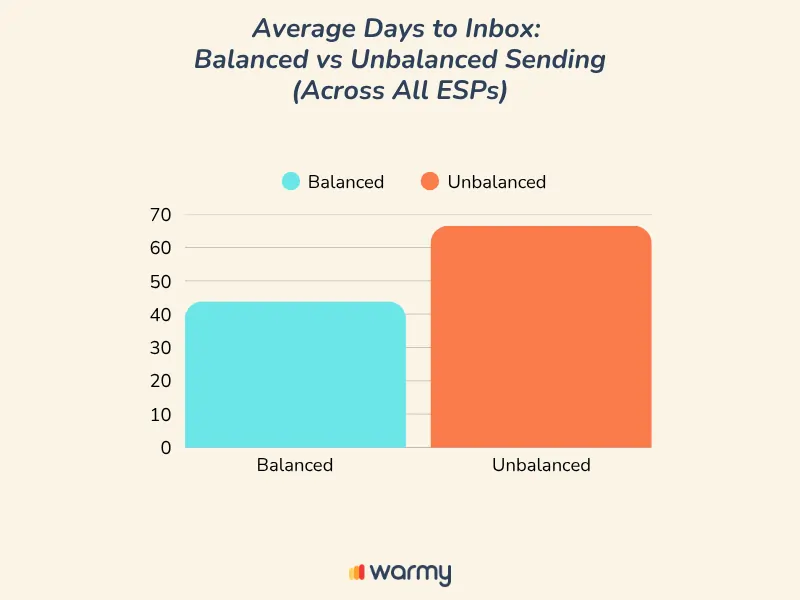If you’ve ever wondered why some domains warm up faster than others, you’re not alone. For marketers and businesses, speed to inbox can make or break a campaign’s success—especially when sending to major providers like Outlook.
With more than 400 million active email users worldwide and an 8.10% market share, getting your emails to land in Outlook inboxes are of the essence.
Our Warmy Research Team conducted a detailed analysis comparing how fast emails get delivered to Outlook inboxes during the warmup process when sent through three popular SMTP providers: SendGrid, MailGun, and Custom SMTP setups.
In this report-backed blog, we’ll reveal what affects inbox placement speed most significantly and which SMTP provider and settings combo yields the fastest results for Outlook.
Ready to unlock the secrets to faster inbox delivery? Let’s dive in.
The research rundown: Why speed to inbox matters
Getting your emails into the Outlook inbox quickly is critical for timely engagement, especially for marketing campaigns, transactional emails, and important notifications. Delays or landing in spam can mean missed opportunities, lower open rates, and diminished ROI.
🔖 Related Reading: Improve Email Deliverability in Outlook
The key question: Which combination of provider and settings gets your emails delivered fastest?
To identify the best approach, our research focused on three widely used SMTP providers:
- SendGrid
- MailGun
- Custom SMTP
We analyzed multiple variables, including:
- IP pool type (Dedicated vs. shared)
- Warm-up template type (Custom vs. default)
- Sending balance (Balanced vs. unbalanced)
- IMAP status (Enabled vs. disabled)
IP pools unpacked: The inbox race between dedicated vs. shared
Understanding these types matters because your sender reputation is tied to your IPs. In a nutshell, dedicated IPs allow you to build and control your reputation, while shared IPs mean your reputation is influenced by the actions of others.
What is a dedicated IP address?
A dedicated IP address means your emails are sent from an IP address exclusive to your domain. For example, if you send 100 emails, all 100 come from the same IP or a pool of IPs assigned solely to you.
What is a shared IP pool?
A shared IP pool means your emails are sent from IP addresses that are also used by other senders. For instance, if you send five emails, each might be sent from a different IP address in a shared pool.
With shared IP pools, outgoing emails are distributed across multiple IP addresses, usually differing only in the last digits (e.g., 213.128.111.254, 213.128.111.291). This distribution means your domain reputation depends partly on the other users sharing those IPs, which can slow down your inbox placement if others send poor-quality emails.
The verdict: Dedicated IP pools are the fast lane to the inbox

Our research shows that emails sent from dedicated IP pools reach the Outlook inbox in approximately 32.4 days on average. This is significantly faster than shared IP pools, which can take nearly three times longer (about 89.3 days).
What this means for your sending strategy
Since each email may come from a different IP within a shared pool, ISPs find it harder to build a consistent reputation for your domain. This inconsistency leads to longer warm-up periods and increased scrutiny, causing delays in inbox placement. Meanwhile, dedicated IP pools’ exclusivity enables ISPs like Outlook to recognize your sending patterns and build trust faster.
Shared IP pools can be a good starting point for low-volume senders but are less effective for businesses aiming for fast, reliable delivery at scale.
🔖 Read also:
- How Long Does It Take to Warm Up an Email Domain for SaaS Companies?
- How Long Does It Take to Warm Up an Email Domain for Cybersecurity
- How Long Does It Take to Warm Up an Email Domain for Fintech Companies
Custom templates vs. default: The power of personalization
When warming up your email domain, you can use either custom templates created by you or the default templates provided by the system:
- Custom templates: personalized email messages that reflect your brand’s tone, style, and content. These templates are crafted to match the actual campaigns you plan to send, maintaining consistency in language and appearance.
- Default templates: pre-designed messages that warm-up tools or email marketing software offers to all users. While functional, they lack brand-specific elements and personalization.
The verdict: Tailored templates turn up the heat faster

Using custom templates speeds up inbox placement to about 30 days on average. In contrast, default templates take roughly 72.8 days to achieve the same inbox placement.
Our findings show that tailoring your warm-up messages to your brand creates more authentic email interactions, which ISPs recognize as legitimate and trustworthy.Generic messages lack the brand consistency and personalized touch that help build trust with ISPs.
What this means for your sending strategy
Custom templates that closely resemble your real campaigns build credibility, helping your domain gain a positive reputation faster. The familiarity and relevance of your messages during warm-up reduce suspicion from email providers, leading to quicker inbox acceptance.
On the other hand, sending warm-up emails that don’t reflect your actual campaigns can slow down your reputation building. This disconnect may cause providers to be more cautious, delaying inbox delivery and increasing the risk of spam filtering.
Personalization matters. Investing time in creating custom warm-up templates aligned with your brand and messaging significantly improves your chances of reaching the inbox faster. While default templates provide a quick start, they cost valuable time in your deliverability journey.
Balancing act: How sending balance influences delivery time
Sending balance refers to how you distribute your outbound email traffic across different SMTP providers or IP addresses.
Decoding balanced sending
In our research, balanced sending means gradually increasing the volume directed to a specific provider, such as Outlook, over time. This gradual ramp-up helps build trust with the provider without overwhelming it.
For example, starting at 5% of your total sending volume and increasing by 2-3% every few days starting from 1,000 emails a day.
On the other hand, unbalanced sending—sending large volumes abruptly to a single provider—can harm your domain reputation. One example is if you have 2,000 emails/day and you suddenly adjust the balance from 0% to 100% for Outlook.
The verdict: Balanced sending makes for gradual growth and faster results

Our findings show that balanced sending results in faster inbox placement, averaging around 43.8 days, compared to 66.5 days for unbalanced sending.
Gradually growing your sending volume to a target provider is a smart strategy to protect your sender reputation and improve delivery speed.
What this means for your sending strategy
Sharp traffic shifts have a negative impact on domain reputation. However, balanced sending results in steady growth—which in turn, signals to ISPs that your sending patterns are legitimate and consistent, reducing the risk of being flagged or rejected.
A sudden spike may look suspicious and trigger spam filters, increasing inbox placement times or even causing outright rejection. Adopting a balanced sending strategy is essential for maintaining a healthy sender reputation and achieving timely inbox placement.
The IMAP factor: Does it really make a difference?
When optimizing email deliverability, many wonder if enabling IMAP (which allows two-way email syncing) impacts how quickly emails reach the inbox.
IMAP enabled vs. disabled
Our study compared inbox placement times between campaigns with IMAP enabled and those without.
- IMAP enabled means the email account can send and receive real-time updates, such as reading, deleting, or replying to emails, and these changes are reflected across all devices
- IMAP disabled means that this syncing capability is turned off. Emails may only be downloaded or accessed without continuous server synchronization, limiting interaction tracking like replies or read status.
The verdict: small impact, big Insight

Emails sent with IMAP enabled reached the Outlook inbox in approximately 49 days, while those with IMAP disabled took about 51.4 days. This roughly 5% difference indicates that IMAP’s effect on inbox placement speed is relatively small and not as critical as other variables.
What does this mean for your strategy
While enabling IMAP may offer slight benefits, it is not a decisive factor in accelerating inbox placement. Factors such as using dedicated IP pools, custom templates, and balanced sending schedules have a much more substantial impact on your email delivery speed.
In short, while IMAP can contribute positively, it should not distract you from optimizing the factors that truly move the needle.
Putting it all together: The fastest combos for Outlook inbox placement

Our research uncovered several critical factors that influence how quickly emails land in the Outlook inbox when sent through popular SMTP providers.
- Dedicated IP pools dramatically speed up inbox placement. Dedicated IPs give you control over your sender reputation, making a huge impact on delivery speed.
- Custom warm-up templates outperform default ones. Custom templates improve credibility and help ISPs trust your messages faster.
- Balanced sending accelerates delivery. Gradually increasing your sending volume to a specific provider (balanced sending) results in faster inbox arrival.
- IMAP has minimal impact on inbox speed. Enabling IMAP slightly improves inbox time, but its effect is minor compared to IP type, template use, and sending balance.
Provider performance varies by setup. SendGrid, MailGun, and Custom SMTP all showed differing inbox times depending on configuration. SendGrid generally performed best average time to inbox landing.

Takeaway: For fastest Outlook inbox placement, use dedicated IP pools with custom warm-up templates, maintain balanced sending practices, and consider—but don’t overly rely on—IMAP. Careful configuration across these factors significantly improves your email deliverability.
Speed up your Outlook delivery with Warmy.io
The findings from our research report highlight the importance of strategic email warm-up, careful sending balance, and personalized templates for achieving fast inbox placement—especially with Outlook. Warmy.io is designed precisely to help you apply these best practices effortlessly, making it easier to optimize your email deliverability.
AI-powered warmup with advanced seed lists
Warmy.io offers AI-powered warmup that intelligently manages sending volume, gradually increasing email traffic while simulating real, engaging interactions. This approach mirrors the research’s recommendation for gradual, steady growth—ensuring your emails reach inboxes faster.
With Warmy.io’s Email Seed List providing a more efficient way to accelerate email warming and improve sender reputation, it provides a next-level approach by imitating real human behavior and sending strong positive signals to email providers.
Balanced sending controls
Warmy.io provides tools to manage sending balance effectively, allowing you to focus on a specific provider or distribute traffic evenly across multiple channels. You can adjust your sending proportions gradually, aligning perfectly with the research’s best practice to avoid sudden volume spikes and maintain a healthy sender reputation.
Template checker for your custom templates
Warmy provides guidance on how to craft content and templates that avoid common spam filters. The template checker analyzes your email to ensure that it complies with best practices for avoiding the spam folder. With this research showing that custom templates make for faster inbox placement, this tool will help you optimize your process even more.
Additionally, Warmy now has a Chrome Extension version of the template checker. This extension helps you assess whether your email is likely to be flagged by spam filters, enabling you to make necessary adjustments before sending. With this extension, you will be able to better determine whether your email will be recognized as spam and make tweaks before sending it.
Your path forward: Implementing research-backed best practices
Our research reveals that achieving fast, reliable inbox placement—especially with Outlook—depends heavily on choosing the right SMTP provider settings, warm-up strategies, and sending practices.
At Warmy.io, we’re committed to turning these insights into actionable tools that empower marketers and businesses to maximize deliverability and protect their sender reputation.
Ready to dive deeper?
Download the full Warmy Research Team report today and get comprehensive data, detailed analysis, and expert recommendations to optimize your email delivery strategy.











